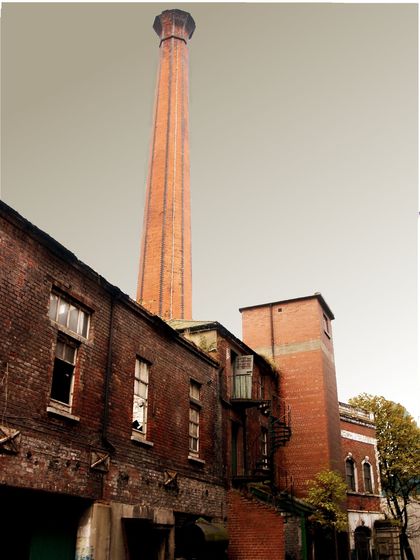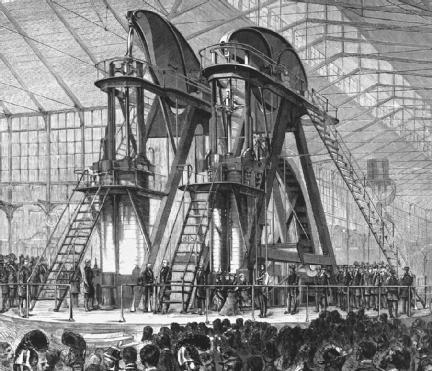Industrial Revolution

Industrial Revolution is the name given to changes that took place in Great Britain during the period from roughly 1730 to 1850. It was originated by German author Friedrich Engels (1820–1895) in 1844. In general, those changes involved the transformation of Great Britain from a largely agrarian (farming) society to one dominated by industry. These changes later spread to other countries, transforming almost all the world.
The Industrial Revolution involved some of the most profound changes in human society in history. Most of the vast array of changes took place in one of three major economic industries: textiles, iron and steel, and transportation. These changes had far-reaching effects on the British economy and social system.
The textile industry
Prior to the mid-eighteenth century, the manufacture of textiles (woven cloth or fabric) in Great Britain (and the rest of the world) took place almost exclusively in private homes. Families would obtain thread from wholesale outlets and then produce cloth by hand in their own houses. Beginning in the 1730s, however, a number of inventors began to develop machines that took over one or more of the previous hand-knitting operations.
In 1733, John Kay (1704–1764) invented the first fly shuttle. This machine consisted of a large frame to which was suspended a series of threads. A shuttle, a device that carried more thread, was then passed through the suspended threads, weaving a piece of cloth. Workers became so proficient with the machine that they could literally make the shuttle "fly" through the thread framework.
Over the next half century, other machines were developed that further mechanized the weaving of cloth. These included the spinning jenny (invented by James Hargreaves in 1764), the water frame (Richard Ark-wright, 1769), the spinning mule (Samuel Crompton, 1779), the power loom (Edmund Cartwright, 1785), and the cotton gin (Eli Whitney, 1792).
At least as important as the invention of individual machines was the organization of industrial operations for their use. Large factories, powered by steam or water, sprang up throughout the nation for the manufacture of cloth and clothing.
The development of new technology in the textile industry had a ripple effect on society. As cloth and clothing became more readily available at more modest prices, the demand for such articles increased. This increase in demand had the further effect of encouraging the expansion of business and the search for even more efficient forms of technology.
Iron and steel manufacture
One factor contributing to the development of industry in Great Britain was that nation's large supply of coal and iron ore. For many centuries, the British had converted their iron ores to iron and steel by heating the raw material with charcoal, made from trees. By the mid eighteenth century, however, the nation's timber supply had largely been used up. Iron and steel manufacturers were forced to look elsewhere for a fuel to use in treating iron ores.
The fuel they found was coal. When coal is heated in the absence of air it turns into coke. Coke proved to be a far superior material for the conversion of iron ore to iron and steel. It was eventually cheaper to produce than charcoal and it could be packed more tightly into a blast furnace, allowing the heating of a larger volume of iron.
The conversion of the iron and steel business from charcoal to coke was accompanied, however, by a number of new technical problems. These, in turn, encouraged the development of even more new inventions. For example, the use of coke in the smelting (melting or fusing) of iron ores required a more intense flow of air through the furnace. Fortunately, the steam engine that had been invented by Scottish engineer James Watt (1736–1819) in 1763 provided the means for solving this problem. The Watt steam engine was also employed in the mining of coal, where it was used to remove water that collected within most mines.
Transportation
For nearly half a century, James Watt's steam engine was so bulky and heavy that it was used only as a stationary power source. The first forms of transport that made use of steam power were developed not in Great Britain, but in France and the United States. In those two nations, inventors constructed the first ships powered by steam engines. In the United States, Robert Fulton's steam ship Clermont, built in 1807, was among these early successes.
During the first two decades of the nineteenth century, a handful of British inventors devised carriage-type vehicles powered by steam engines. In 1803, Richard Trevithick (1771–1833) built a "steam carriage" which he carried passengers through the streets of London. A year later,

one of his steam-powered locomotives pulled a load of 10 tons for a distance of almost 10 miles (16 kilometers) at a speed of about 5 miles (8 kilometers) per hour.
Effects of the Industrial Revolution
The Industrial Revolution brought about dramatic changes in nearly every aspect of British society. With the growth of factories, for example, people were drawn to metropolitan centers. The number of cities with populations of more than 20,000 in England and Wales rose from 12 in 1800 to nearly 200 in 1900.
Technological change also made possible the growth of capitalism. Factory owners and others who controlled the means of production rapidly became very rich. In the years between 1800 and 1900, the total national income in Great Britain increased by a factor of ten.
However, working conditions in the factories were poor. Men, women, and children alike were employed at extremely low wages in crowded, unhealthy, and dangerous environments. Workers were often able to afford no more than the simplest housing, resulting in the rise of urban slums.
These conditions soon led to actions to protect workers. Laws were passed requiring safety standards in factories, setting minimum age limits for young workers, establishing schools for children whose parents both worked, and creating other standards for the protection of workers. Workers then began to establish the first labor unions to protect their own interests; as a group they had more power when bargaining with their employers over wages and working conditions.
thanks at all
how wet steam engine start textile mills?
sir please i am the student of electrical engineering
was good with a lot of information